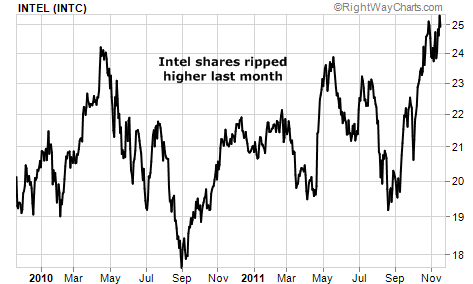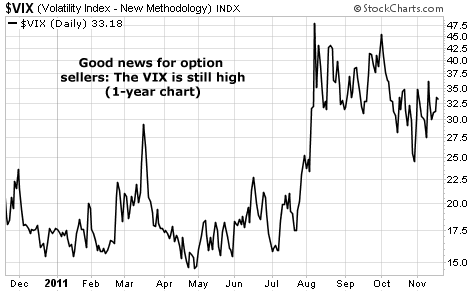| Home | About Us | Resources | Archive | Free Reports | Market Window |
How to Make 80% a Year While Stocks Go NowhereBy
Friday, November 18, 2011
A friend of mine is in an "unusual situation"...
He wrote me a note a few weeks ago to ask my advice. "There I was," he told me, "happily collecting easy money... and then this happened."
The problem was that a stock he was trading had done something he wasn't happy about. It skyrocketed.
No, he wasn't selling it short. "Even though I'm long," he wrote, "I'm not particularly pleased with the move. I was making more money when this stock was drifting sideways."
For most folks, that is unusual. But my friend has been collecting that kind of "easy money" for years. It's simpler than you think. Here's how...
My friend was making a trade on semiconductor giant Intel.
For about two years, Intel's share price didn't go much of anywhere. It was stuck in a tight range between about $18 and $22. Though the company pays a growing dividend, anyone who bought the stock over that time frame hadn't seen much in the way of capital gains... until last month, when shares ripped higher.
 That move from $20 to $25 is what had my friend upset. You see, over the last two years or so, he'd been using Intel to generate regular payouts of 10% to 20% – earning up to 80% annualized returns. His last trade, which he put on in September, paid out an easy $2,400.
He was doing it by selling puts. I know a lot of readers are going to stop right there. "Too complicated!" you might think. "And too risky!" But it's a simple idea. It's actually much safer than just owning shares of a stock, as I'll show. And you can do what my friend did and make money even if stocks go nowhere.
First, you need to find the right kind of stock to trade. My friend had the same take on Intel as I do. He told me, "Intel is a super-dominant company. It was super-cheap. And my studies of the fundamentals and price action told me it was extremely unlikely to go down."
This is exactly where a put-selling strategy is most effective: You make money simply if the stock does not go down.
You see, when you sell a put, you're agreeing to buy a stock below the market price within a set time. You get paid for making that agreement. If the stock never drops below that price, you get to keep the cash. If the stock does drop below that price, the cash ensures you get a discount to that price. It's like getting paid to offer $250,000 for a house the buyer is asking $300,000 for.
It works great in sideways markets. Even if stocks fall, the cash you're collecting gives you a cushion regular shareholders don't have. The only "problem" is if stocks go up...
Once shares of Intel hit $25, the trade just wasn't as attractive to my friend as it had been. "Intel is no longer super-cheap and super-unlikely to go down," he complained. "Now... it's just kind of cheap and kind of unlikely to go down. The big move higher makes selling puts on Intel less of a no brainer for me."
I told him it was a good problem to have. He'd had a good run with Intel. He'd made plenty of money without taking on a lot of risk. All he has to do now was find another opportunity.
I know he'll do fine, because he's got the "rich trader's" view of the market...
In short, he isn't sweating for a big, risky gamble to pay off. He's happy enough – and making plenty of money – if stocks just amble sideways. And he's got a big margin of safety in case stocks go down.
It's an "unusual" way to trade. But it's one of the market's best shots at safe, easy money.
Here's to our health, wealth, and a great retirement,
Doc Eifrig
Further Reading:
"If you think the Federal Reserve's 'zero-percent interest' policy means 'zero investment income,' think again," Doc writes. "If you're looking for income, this is exactly the opportunity you need."
You could sit back and collect your 3%-4% dividend on shares of Microsoft. Or you could do a little more work and juice your gains to double-digit returns. "If you're interested in collecting safe, 15%-plus yields," Doc writes, "you should consider this idea immediately." Learn more here: How Digital Utilities Could Pay for Your Retirement.
Market NotesGOOD NEWS FOR OPTION SELLERS For folks who are taking today's essay to heart and are planning to sell options, we've got good news in the chart below.
Over the past few years, we've highlighted how you can generate huge amounts of safe, conservative income by selling stock options... and we know many folks have taken this valuable advice. (You can read some of our best pieces here, here, and here.)
When it comes to selling options, the more fear there is in the market, the better. Fear fattens the price of options... which allows contrarian traders to generate incredible gains. You can track the "fatness" of these option payments by monitoring the Volatility Index, aka "the VIX."
Known as the market's "fear gauge," the VIX measures the price folks are willing to pay up for protective stock options. When the VIX is below 18, we can say the market is calm... and option prices are low. When the VIX is over 30, we can say the market is full of fear... and option prices are high.
As you can see from today's chart, the VIX has spent much of the year below 18. Then, this summer, Europe's sovereign debt crisis advanced to the next inning. The VIX skyrocketed to 45... and remains at elevated levels. For option sellers, this means the sun is out... and it's still time to make hay.
 |
In The Daily Crux
Recent Articles
|


